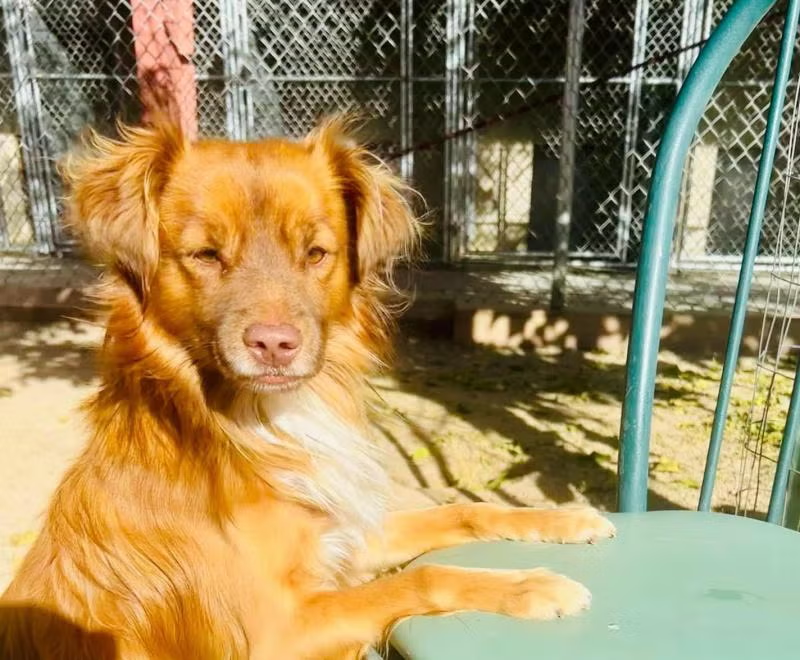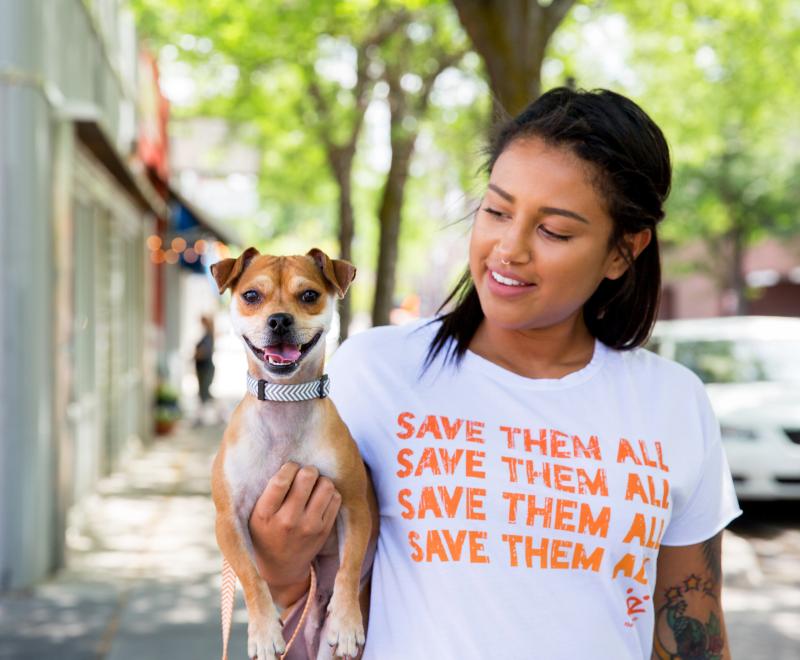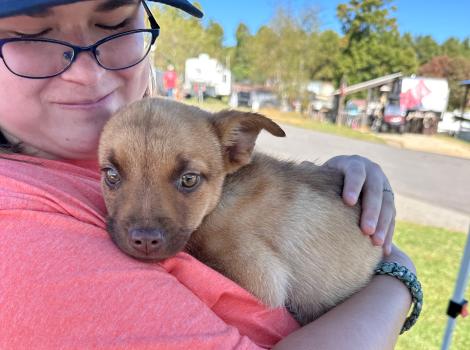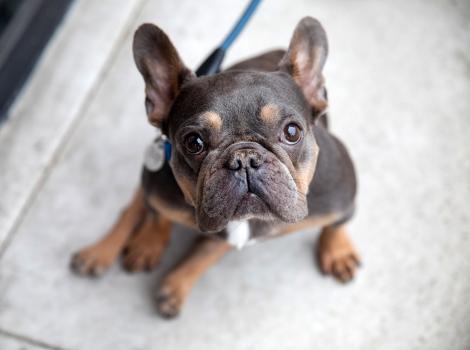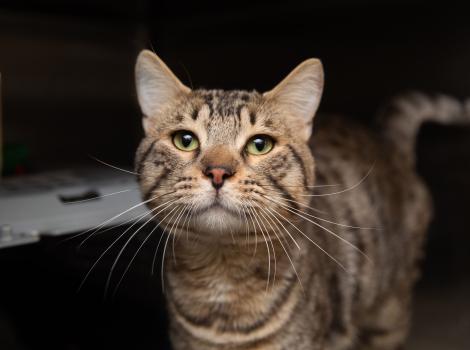Helping a small rural animal shelter sustain no-kill

Katie Bird has a most difficult job. As the supervisor of the Inyo County Animal Shelter in Big Pine, California, she and a staff of two animal services officers must cover all 10,000 square miles of the ninth largest county in the United States.
How does she do it? “As best we can,” says Katie, who grew up in nearby Bishop, California, surrounded by all kinds of pets: dogs, cats, horses, and birds. “I went off to college for art, and somehow I wound up in animal welfare.”
Since she became the new shelter supervisor last May, she’s faced reorganization, strained resources, and a depleted staff — all in addition to assuming the top job. But despite the challenges, the rural shelter continues to average a save rate above 90%, the threshold for no-kill status.
Helping animal shelters across the United States keep operating at a high level, even when the going gets tough, is one of the ways Best Friends Animal Society is helping shelters reach no-kill by 2025.

A helping hand during a difficult time
Since last May, Best Friends has been assisting Inyo County in several ways to help the shelter maintain its high save rate. Best Friends provided grants to cover certification training for two new animal services officers.
“As the new supervisor in a new situation, Katie needed some help,” says Anna Walton, national shelter support strategist for Best Friends. “We’ve been able to provide advice on a range of animal care issues, provide some supplies, and we’ve helped the shelter implement trap-neuter-vaccinate-return (TNVR) as a way of managing community cats.”
Katie adds, “Best Friends provides us with tons of resources. Following our upper respiratory outbreak last summer, we had to clear out the cat playroom and start fresh with new equipment. Anna got us new cat trees.”

Hands-on experience
It didn’t hurt that Katie’s experience at the Inyo County shelter dates back to 2008. She worked just about every job in the shelter before becoming an animal services officer in 2013. Despite being short-staffed due to turnover, she was able to hit the ground running as shelter supervisor with her knowledge of the shelter and the vast county it serves.
The county, which rebuilt the shelter in 2014, still utilizes an old dairy barn built in the 1940s as a separate quarantine area. “We have 22 kennels for dogs in the new space,” Katie says, “so there’s not much space. We just had a litter of puppies come in that bumped (up) our numbers.”
That’s the way it is at Inyo County — small facility and a small staff juggling multiple responsibilities. Animal services officers clean the kennels as well as make the rounds in the community. The staff is usually on the run from one project to another, just to keep pace with the requests.

Lots of time on the road
The department must handle animal services for a huge geographic area that includes the nearby city of Bishop. Half of the county is located in Death Valley National Park, and the entire county population of about 19,000 residents is spread over a vast, often desolate area.
Inyo County is also the traditional homeland of the Paiute, Shoshone, and Kawaiisu people. Today, there are five federally recognized tribes in the area: Bishop Paiute Tribe, Big Pine Paiute Tribe, Fort Independence Indian Community of Paiute Indians, Lone Pine Paiute Shoshone Tribe, and Timbisha Shoshone Tribe. And while Inyo County Animal Services doesn’t have much jurisdiction on tribal reservations, a future goal of the local sheriff’s department is to meet with tribal leaders to discuss mutual animal welfare issues.
[Helping small animal shelters has a big impact]
“We spend a lot of time up and down the highway,” says Katie, “and we never know what the day will bring. Every day is an adventure, and you really don’t know where you will end up. We just got an email from someone who says they have 11 puppies out in Charleston View (near Las Vegas). We might have to have someone drop everything and make an overnight run out there.”

TNVR on the horizon
Besides the grants from Best Friends, Inyo County has received a $10,000 grant from the California Animal Welfare Funders Collaborative, and Katie says the funds have been designated for trap-neuter-vaccinate-return for community cats (free-roaming cats who live outdoors). “It’s become a passion of mine,” she says, “and right now I’m just trying to structure a program for us in spite of the fact that we don’t yet have a vet on-site. We’ll have to coordinate spay/neuter with local vets and set it up to where we can track the information.”
Katie says local businesses and residents around Big Pine and Bishop have been supportive. “If we need assistance transporting animals to different locations or sponsoring a low-cost adoption event, the local community has been there. This has been a big help in that we’ve worked really hard to maintain our save rate. I also have to give a lot of credit to my volunteers.”
[Amazing progress at Brownsville animal shelter]
In the coming months Katie plans to fill her remaining staff openings and eventually get to the point where she can get out of the office more to do some training with her animal services officers. That will include field trips out through Death Valley to visit the many diverse communities in the county.
“I’m one officer away from getting there,” she says. “Up to now, I’ve spent a lot of time just babysitting the shelter to keep it up and running while we get our staff all trained up. Now I need to get in the field with my officers and show them the ropes.”
With 10 years of experience in the field, Katie is the perfect person to mentor her new staff. But beyond hands-on training, she also wants the shelter to keep up its good work and expand it.
“Our work is moving forward, and I think in the future we’ll be able to take better advantage of our work with Best Friends and really take a closer look at all they are offering. We’re looking to learn even more and build some good programs that will not just help the shelter but extend out to the community, too.”

Let's make every shelter and every community no-kill by 2025
Our goal at Best Friends is to support all animal shelters in the U.S. in reaching no-kill by 2025. No-kill means saving every dog and cat in a shelter who can be saved, accounting for community safety and good quality of life for pets.
Shelter staff can’t do it alone. Saving animals in shelters is everyone’s responsibility, and it takes support and participation from the community. No-kill is possible when we work together thoughtfully, honestly, and collaboratively.
